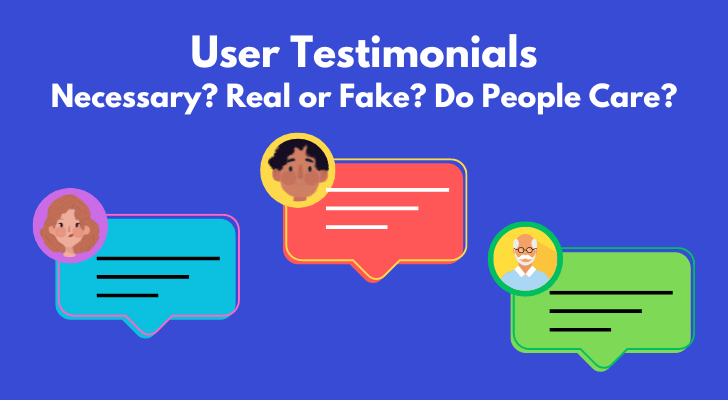User testimonials have lost their credibility due to the prevalence of fake testimonials. Anyone can create artificial reviews - use fake photos or get someone to read a script in front of a camera. It has become a standard marketing method for many, thus undermining the trustworthiness of user testimonials.
With that said, people have shorter attention spans and patience for things that don't bring immediate gratification. Whereas asking users for authentic, quality testimonials can be a time-consuming process with no guarantee of results. Then isn’t it much wiser to create fake testimonials? This way, you'll have complete control over the content and will not have to wait for someone else to provide feedback or reviews on your product or service.
So what do you think about fake testimonials that you often see on Make-Money-Online services sites?
But first of all, go back to the basics and check out what a (real) user testimonial is all about.

What Is a Testimonial?
A testimonial refers to a statement or endorsement given by a customer, client, or user expressing their positive experience, satisfaction, or feedback about a product, service, or brand. Testimonials serve as a way to showcase the real-life experiences and opinions of individuals who have interacted with a particular offering. The purpose is to provide potential customers with insights and reassurance about the quality, value, and benefits of a product or service. By sharing positive experiences, testimonials can influence the purchasing decisions of others and help businesses establish a positive reputation.
Testimonials can take various forms, including written testimonials, video testimonials, audio testimonials, online reviews, social media posts, or quotes attributed to the customer. They are commonly used in marketing and advertising to build trust, credibility, and social proof.
Did You Know?
- 90% of consumers read online reviews before visiting a business.
- 84% of people trust online reviews as much as personal recommendations.
- Approximately 20% of Yelp reviews are suspected to be fake.
- Businesses with 2-star ratings receive 90% fewer purchases than those with 4-star ratings.
- 95% of consumers suspect censorship or fake reviews if there are no negative reviews.
How to Get (Authentic) User Testimonials
So how do people go about getting them? Here are some ways;
Directly ask satisfied customers
Reach out to your satisfied customers and ask them if they would be willing to provide a testimonial. You can contact them via email, phone, or even through social media platforms. Be polite and explain why their feedback is important to you.
Conduct surveys or feedback forms
Create a simple survey or feedback form that allows users to provide their testimonials. You can send the survey link via email, embed it on your website, or share it through social media channels. Ask specific questions about their experience with your product or service, and provide an open-ended section where they can write their testimonial.
Offer incentives
Consider offering a small incentive, such as a discount, free trial, or exclusive content, to encourage users to provide testimonials. This can increase participation and motivation.
Engage on social networks
Monitor your social media channels for positive comments or messages from users who express satisfaction with your product or service. Reach out to them and ask if they would be willing to turn their feedback into a testimonial. You can also create dedicated posts or campaigns asking for testimonials directly on your social media profiles.
Create a dedicated testimonial page
Set up a dedicated page on your website where users can submit their testimonials directly. Provide clear instructions on how to submit and what kind of information you're looking for. Make it easy for users to provide testimonials by including a form or an email address.
Use online review platforms
Encourage satisfied customers to leave reviews on popular review platforms relevant to your industry, such as Google Reviews, Yelp, Trustpilot, or industry-specific platforms. These platforms often have built-in systems for collecting and displaying testimonials.
Did You Know?
- 30% of consumers assume online reviews are fake if there are no negative critiques.
- Around 70% of Amazon reviews for certain popular products were found to be unreliable.
- Fake reviews can increase business revenue by up to 5% on Yelp.
- Over 50% of consumers have encountered a fake review in the last year.
- A single negative review can drive away approximately 22% of customers.
Follow up with customers
After a customer has made a purchase or used your service, follow up with them to see how everything went. If they express satisfaction, kindly ask if they would be willing to provide a testimonial based on their positive experience.
To make things easy for users to leave testimonials, you should;
- Keep it simple: Provide clear instructions on how to submit testimonials. Simplify the process with a short form or an email address.
- Set clear expectations: Let users know the desired format, such as a three-word testimonial or a brief sentence.
- Use social media: Leverage platforms like Twitter or Instagram, where users can easily share testimonials using hashtags or mentions.
- Provide examples: Offer a few sample testimonials to inspire users and make it easier for them to craft their own.
- Minimize steps: Reduce any unnecessary requirements or forms to make the submission process quick and hassle-free.
- Be accessible: Ensure users can submit testimonials from different devices, and be available to assist if they need help.
Always respect your users' privacy and seek their consent before using their testimonials publicly. Make it clear how you intend to use their testimonials and provide them with the option to remain anonymous if they prefer.

How Long Should Each Testimonial Be?
The length of a testimonial can vary depending on the specific circumstances, context, and platform where it will be used. While there is no strict rule on the exact length, here is a general guideline:
- Short and concise: Aim for testimonials that are succinct and to the point. They should capture the key message and happy experience in a concise manner.
- One to three sentences: In many cases, a testimonial consisting of one to three sentences can be effective. It provides a brief but impactful endorsement or review.
- Brief paragraph: Testimonials that range from a few sentences to a short paragraph are also common. This length allows for a bit more detail, including specific benefits or aspects appreciated by the customer.
The goal is to provide enough information to showcase the good experience and endorsement while keeping it concise and easy to read. Testimonials that are too long may risk losing the reader's attention.
Did You Know?
- 94% of online shoppers reported that a negative review has convinced them to avoid visiting a business.
- Businesses can see a 5-9% increase in revenue for each additional star on Yelp.
- 80% of consumers have changed their mind about a purchase after reading negative reviews.
- 40% of consumers form an opinion by reading just 1-3 reviews.
- The Federal Trade Commission fined a company $12.8 million for fake reviews in 2019.
"Best Product Ever"
Should They Provide Their Photo?
Asking users to include a photo with their testimonials can add an extra personal touch and credibility to their feedback. However, it's important to approach this request thoughtfully and consider the following points:
- Privacy and consent: Ensure that you obtain explicit consent from users before using their photos alongside their testimonials. Respect their privacy rights and make it clear how their photo will be used.
- Relevance and context: Consider whether including photos aligns with the purpose and platform where the testimonials will be displayed. In some cases, such as on websites or marketing materials, photos can enhance the authenticity of the testimonial. However, in other instances, such as brief testimonials on social media, it may not be necessary or appropriate.
- Ease of submission: Make it easy for users to submit their photos by providing clear instructions and a user-friendly method, such as an upload form or an email address specifically for photo submissions.
- Alternatives: If users are not comfortable providing a photo, offer alternative options, such as using an avatar or initials to accompany their testimonial. Respect their preferences and provide them with choices.
Incentivize Participation
Offering incentives, such as discounts, rewards, or entry into a contest, is a great way to encourage users to submit testimonials. It should always be done fairly and transparently, though. Just follow ethical guidelines and ensure that:
- The incentive is offered as a token of appreciation, rather than a direct exchange for a positive testimonial.
- Users are free to provide their genuine feedback, whether positive or negative, without any pressure or expectation of a specific outcome.
- Transparency is maintained by clearly stating that the incentive is offered for participation and not for specific testimonial content.
This is just to encourage voluntary and honest testimonials from satisfied users. So you should approach incentives with integrity and respect for the user's freedom to express their genuine opinions.
Did You Know?
- 4 out of 5 consumers have changed their minds about a recommended purchase after reading negative online reviews.
- Nearly 10% of all online reviews are estimated to be fake.
- Companies can increase their rating by 0.5 stars on Yelp by increasing fake reviews by 10%.
- Over 70% of consumers feel that trust in reviews is essential to their purchasing decisions.
- The presence of fake reviews has led 85% of consumers to question the authenticity of all reviews.
Should I Create Fake User Testimonials Myself?
It's common for people to create fake user testimonials, including using fake photos, known as testimonial fraud or review fraud. Fake testimonials can be created for various purposes, such as promoting a product, boosting the reputation of a business, or manipulating public opinion.
I've been enjoying reading CyberCash Worldwide for over 10 years now. This site amazes me every time I visit. I find the information truly educational and am so happy to learn something new each time. Thank you so much! And sorry my useless fake testimonial has no quality whatsoever.
Tennessy Timberlake
The use of fake photos in testimonials is aimed at making the testimonial appear more authentic and trustworthy. By associating a seemingly real person with a positive review, the intention is to persuade others to trust the product or service being promoted. Needless to say, this practice is deceptive and unethical, as it misleads consumers and undermines the credibility of genuine user testimonials.
But if you really need to create fake testimonials, keep in mind that users can take all sorts of steps to evaluate the authenticity of your testimonials and determine if it is real or fake.
For example, they;
- Look for specific details: Genuine testimonials often include specific details about the user's experience, such as how the product or service solved a particular problem or benefited them in a specific way. Vague or generic testimonials lacking specific information could be a red flag.
- Verify the source: They often check the credibility of the platform or website where the testimonial is posted. Established and reputable platforms tend to have better moderation and verification processes in place. Experienced users are cautious of testimonials on unfamiliar or lesser-known websites.
- Cross-reference with other sources: People search for additional reviews or testimonials from different platforms or sources. If a product or service only has glowing reviews on a single website, it may indicate biased or fake testimonials. They always look for a variety of opinions and experiences.
- Assess the language and writing style: They pay attention to the language and writing style of the testimonial. Genuine testimonials often have a natural, personal tone. Testimonials that appear overly promotional, scripted, or excessively positive without any critical remarks are fake.
- Check for consistency: If the testimonial includes a username or additional information about the user, they can verify its consistency across different platforms or instances. Inconsistencies in usernames, profile information, or photos may indicate fake testimonials.
- Reverse image search: If the testimonial includes a photo, we can perform a reverse image search using tools like Google Images. This can help us identify if the photo has been used elsewhere on the internet or if it is a stock photo, potentially indicating a fake testimonial.
So if you really have to pretend, be aware of those points.
No matter what business you own or what type of products and services you offer, there will always be both happy customers and unhappy customers. Then you might as well create a few fake positive testimonials that showcase the quality of your product and influence a potential customer's decision-making process.
It also serves as an excellent way for current customers to feel reassured about their choice in purchasing from you. Ultimately, while creating false feedback may seem dishonest at first glance, it’s often necessary in order to draw more attention and encourage future purchases from satisfied buyers.
Are Testimonials Really Necessary?
The use of testimonials is a marketing strategy that can bring several benefits to businesses, but their necessity can vary depending on factors such as industry, target audience, and marketing goals. While testimonials are commonly used to build trust, credibility, and social proof, their absolute necessity may not apply universally to all businesses.
Some businesses may find testimonials to be a crucial element of their marketing efforts, particularly in industries where customer trust and confidence play a significant role. Testimonials can be especially valuable for businesses that operate online, provide services, or offer products that rely heavily on customer experiences.
But there may be situations where testimonials are not the primary focus or where other forms of validation and credibility-building methods are given more emphasis. Established and well-known brands, for example, may rely more on their reputation, brand equity, and other marketing strategies to convey trustworthiness.
At the end of the day, the decision to incorporate testimonials into your marketing strategy should be based on an assessment of your business's specific circumstances, industry norms, customer preferences, and overall marketing objectives. It is important to consider the potential benefits of testimonials and how they align with your broader marketing efforts.
How I "Finally" Make Over $7,000 Monthly Income
"The most valuable thing I've ever done!"





